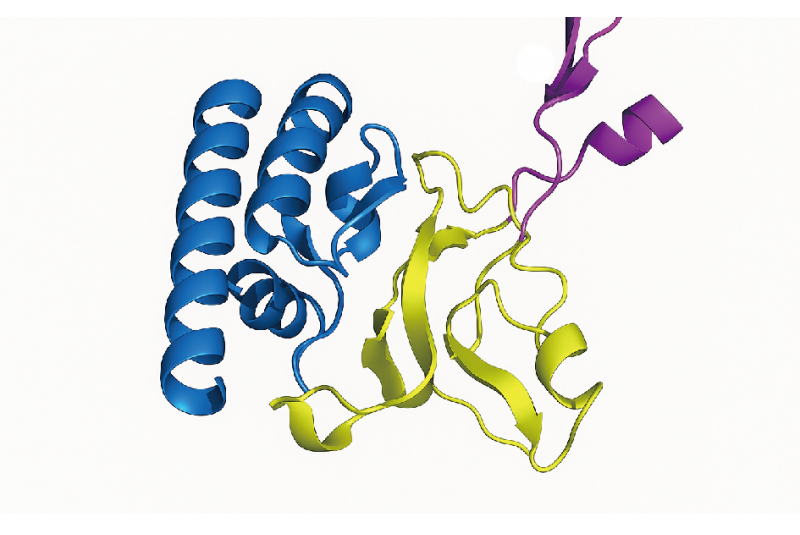T7 RNA Polymerase
Bacteriophage T7 RNA Polymerase is a DNA-dependent RNA polymerase with high specificity for the T7 promoter. This enzyme catalyzes the 5’→3’synthesis of RNA from DNA downstream from its promoter.
T7 RNA Polymerase, T7 RNA聚合酶
Source
Escherichia coli
Purity
>98% as determined by SDS-PAGE. Purified by Ni-NTA chromatography.
Unit Definition
One unit is defined as the amount of the enzyme incorporates 1 nmol of ATP into acid-insoluble product in 1 hour at 37°C.
Reaction Condition
1X RNA Polymerase Reaction Buffer, supplemented with 3 mM each ATP, UTP, GTP, CTP, and DNA template containing the T7 RNA Polymerase promoter. Incubate at 37°C.
10X RNA Polymerase Reaction Buffer: 400 mM Tris-HCl (pH 8.0), 60 mM MgCl2, and 20 mM spermidine.
Storage Buffer
T7 RNA Polymerase is supplied in 100 mM Tris-HCl (pH 7.9), 20 mM KCl, 1 mM DTT, 1 mM EDTA, 0.1% Triton® X-100 and 50% (v/v) glycerol.
Storage
Store at -20°C for up to 6 months, and it is recommended to store at -80°C for long-term preservation. Avoid repeated freeze/thaw cycles.
Handling Instruction
For optimal storage, aliquot the enzyme, reaction buffer and DTT reagent into smaller quantities and store at recommended temperature.
Avoid extended exposure to ice; instead, promptly retrieve the required portion and return it to the appropriate storage temperature.
Notes
1. Transcription reaction should be performed under RNase free condition. Use nuclease-free tubes, reagents, and water to avoid RNase contamination. Also, wear gloves when working with RNA.
2. To obtain optimal condition, NTP concentration can be titrated between 3 – 5 mM.
3. The volume of T7 RNA Polymerase can be titrated between 1-2 μL in the IVT reaction to optimize your assay.
Shipping Conditions:
Dry ice
Escherichia coli
Purity
>98% as determined by SDS-PAGE. Purified by Ni-NTA chromatography.
Unit Definition
One unit is defined as the amount of the enzyme incorporates 1 nmol of ATP into acid-insoluble product in 1 hour at 37°C.
Reaction Condition
1X RNA Polymerase Reaction Buffer, supplemented with 3 mM each ATP, UTP, GTP, CTP, and DNA template containing the T7 RNA Polymerase promoter. Incubate at 37°C.
10X RNA Polymerase Reaction Buffer: 400 mM Tris-HCl (pH 8.0), 60 mM MgCl2, and 20 mM spermidine.
Storage Buffer
T7 RNA Polymerase is supplied in 100 mM Tris-HCl (pH 7.9), 20 mM KCl, 1 mM DTT, 1 mM EDTA, 0.1% Triton® X-100 and 50% (v/v) glycerol.
Storage
Store at -20°C for up to 6 months, and it is recommended to store at -80°C for long-term preservation. Avoid repeated freeze/thaw cycles.
Handling Instruction
For optimal storage, aliquot the enzyme, reaction buffer and DTT reagent into smaller quantities and store at recommended temperature.
Avoid extended exposure to ice; instead, promptly retrieve the required portion and return it to the appropriate storage temperature.
Notes
1. Transcription reaction should be performed under RNase free condition. Use nuclease-free tubes, reagents, and water to avoid RNase contamination. Also, wear gloves when working with RNA.
2. To obtain optimal condition, NTP concentration can be titrated between 3 – 5 mM.
3. The volume of T7 RNA Polymerase can be titrated between 1-2 μL in the IVT reaction to optimize your assay.
Shipping Conditions:
Dry ice
Standard RNA synthesis procedures:
1. Below reaction mixture should be prepared under room temperature and combined in the following order:
2. Incubate at 37°C for 30 minutes to 2 hours.
3. Above reaction mixture may be scaled up or down proportionately.
1. Below reaction mixture should be prepared under room temperature and combined in the following order:
| Component | Amount | Final concentration |
| Nuclease-Free H2O | X μL | - |
| Template DNA | 0.5-1 μg | - |
| 10X RNA Polymerase Reaction Buffer | 2 μL | 1X |
| ATP (100 mM) | 1 μL | 5 mM |
| UTP (100 mM) | 1 μL | 5 mM |
| CTP (100 mM) | 1 μL | 5 mM |
| GTP (100 mM) | 1 μL | 5 mM |
| 100 mM DTT | 2 μL | 10 mM |
| T7 RNA Polymerase (200 U/μL) | 1 μL | - |
| RNase inhibitor (optional) | 0.5 μL | 1U/μL |
| Inorganic Pyrophosphatase (optional) | 0.5 μL | 0.0025 U/μL |
| Total reaction volume | 20 μL | - |
3. Above reaction mixture may be scaled up or down proportionately.
SEC-HPLC Analysis

mRNA purity analysis after synthesizing using T7 RNA polymerase
dsRNA Analysis

Croyez's final mRNA product has a significantly lower concentration of dsRNA byproducts compared to the competitor's product.
Capping Efficiency Analysis

Delivery of GFP mRNA to HEK293 cells


mRNA purity analysis after synthesizing using T7 RNA polymerase
dsRNA Analysis

Croyez's final mRNA product has a significantly lower concentration of dsRNA byproducts compared to the competitor's product.
Capping Efficiency Analysis

Delivery of GFP mRNA to HEK293 cells



